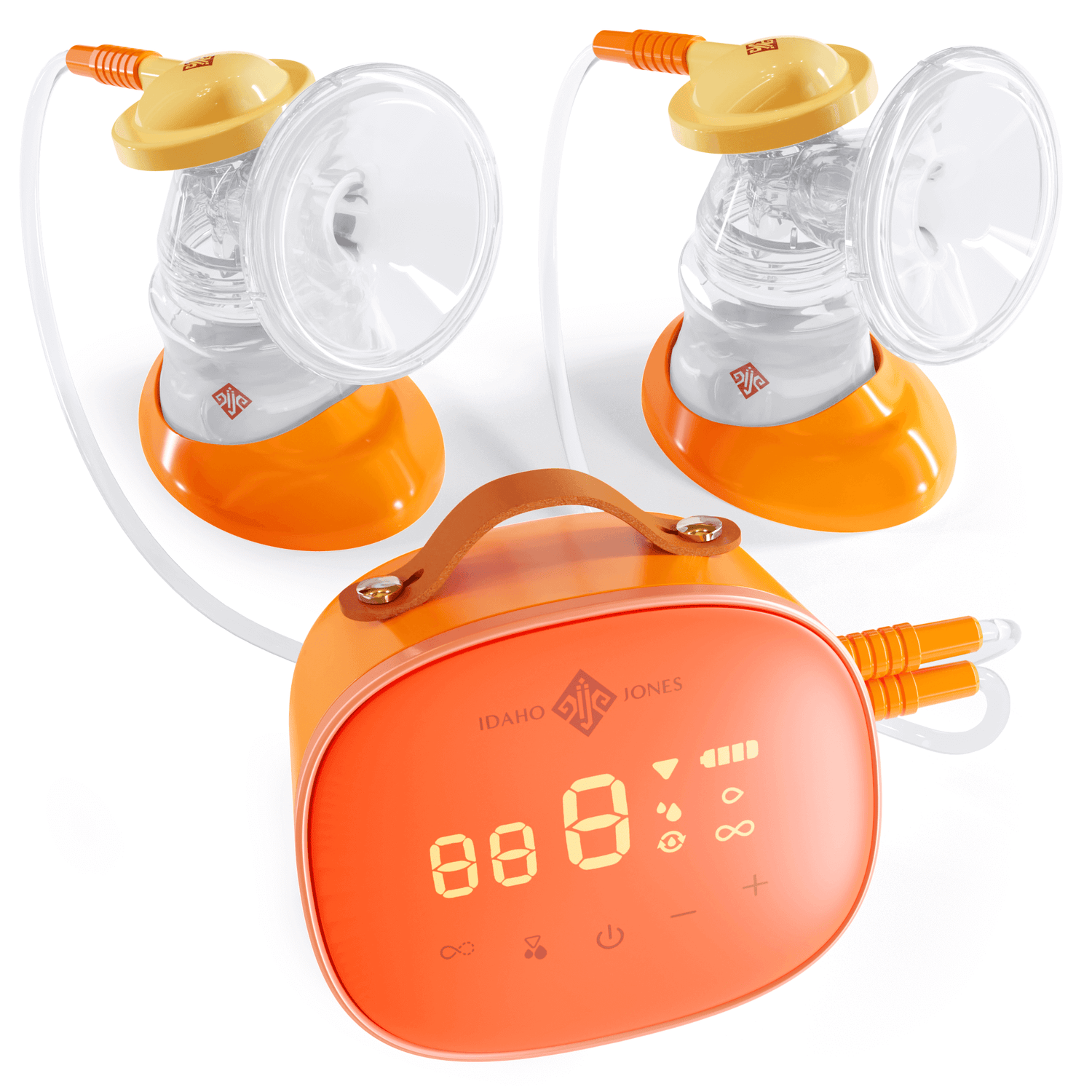
How Much Should My Newborn Eat?
Share
Your baby is here—amazing! Now, how much should a newborn eat? We generally place a lot of emphasis on birth, and then the adorable baby that’s joined your family, sometimes forgetting about the exhausting day-to-day experience of parenting a new, tiny human through their first days and weeks of life. To understand how much milk your newborn needs, it helps to know how much storage space they have to begin with.
Newborn Stomach Size
Whether through a quick web search or a session on breastfeeding in your childbirth education class or parenting book, you will likely hear at some point that a newborn’s stomach is the size of a cherry, around 5-7 mL. This seems tiny, right!? While your new baby is indeed relatively tiny, this previously accepted measurement of the average newborn stomach hasn’t held up in newer scientific studies.
Nils Bergman, a Swedish perinatal neurologist who researches and promotes skin-to-skin for mothers and their infants, summarized existing research on newborn stomach size in 2013, finding that the average newborn stomach size was around 20 mL an hour after birth, much larger than the “cherry” or “half tablespoon” size commonly described.
While stomach size is an important part of figuring out how much a newborn should eat, it’s not the only factor. Remember that your baby is learning all of this alongside you: they must also figure out how to tell you they need food, how to get that food into their body, and how to deal with difficult things like cold, hunger, and tiredness for the first time.
Number of Feeds
No matter the exact size of their stomachs, all newborns need to feed frequently during the first few days and weeks of life. It’s generally recommended that newborns eat 8-12 times in a 24 hour period, which translates to every 2-3 hours. Some babies feed even more frequently at times, eating every hour or multiple times an hour. Generally, as long as a baby is eating at least those 8 times per day, they are within the range of normal. If your baby eats very frequently and it's hard to sustain the pace, it could be helpful to work with a lactation professional to ensure that your baby is transferring milk well and able to get what they need without nursing constantly. Newborns are small and needy tiny humans, however, and it's normal that they want to be very close to their caregivers, almost constantly during the first few months of life especially.
Milk Transition
When your baby is born, your body has already been making milk for some time, even if you haven't had any leaks or hand expressed any milk. This first milk is called colostrum, and is often a golden color, though it can also appear creamy or clear. Colostrum, sometimes called "liquid gold" is a low volume milk, and it may seem like it's not very much for your newborn in the first hours of life. However, it has high protein levels that help maintain blood sugar levels, meaning that even a few drops go far in satiating your baby's hunger. Your baby needs to feed often in the first days of life, and it's common that your little one will nurse especially frequently on the second or third day to help your milk transition to transitional milk and then mature milk.
Transitional milk is in between colostrum and mature milk. As your colostrum starts to change, the volume of milk your body makes will increase and your milk might start to look more clear and then white, appearing more like the dairy products we often think of when we hear the word "milk." This transitional milk will slowly change into mature milk around day 10-14 postpartum. As your milk supply builds and regulates, you may notice some fullness or even engorgement in the first few days. Breastfeeding or pumping frequently will tell your body to continue making milk for your baby as well as help keep you from getting clogged ducts or mastitis.
Even though we know that all newborns need to feed frequently in the early days of life, the number of feeds will vary from baby to baby and day to day. Since colostrum is thicker than mature milk, as well as low in volume, and baby is small and learning how to eat without much energy or stamina, frequent feedings in the first few days postpartum will help bring in a stable and abundant milk supply, as well as make sure your newborn is both eating enough in the short term and learning how to eat well in the long term. As your milk transitions, your baby will start to increase their volume of intake.
Hunger Cues
Whether your newborn is taking their milk from your breasts or a bottle (or both), following their cues will help you know how much a newborn should eat. You likely don’t know your exact stomach size, but you know when you’re hungry or full. Even the most primitive animals know when to eat and stop eating. Your baby is the same! Instead of scratching your head asking “how much should a 2 week old eat?” you can pay attention to your baby’s hunger cues and know just what they need and when.
Your baby’s hunger cues may include early signs of hunger like:
- Stirring from sleep
- Rooting around to look for a nipple
- Mouth opening
- Smacking lips
- Reaching or sticking out their tongue
- Clenched fists
Mid-stage hunger cues:
- Stretching
- Increased movement
- Putting hand to mouth
- Seeming to crawl, often towards the breast
- Furrowed brow
Late hunger cues:
- Fussy behavior
- Crying or screaming
- Agitated body movements
- Turning red in color
Crying is a late stage hunger cue, meaning that your baby is really ready for some milk by the time they start to cry or scream. Learning how your baby acts when they are hungry can help you know to feed them before they get very upset. If your baby seems like they’re looking for something, even before they open their eyes from a nap, your newborn is very likely looking for something—you! And your milk. Feeding a baby at those early signs of hunger can make feeding easier for both of you.
Signs of Growth
In addition to following your baby’s hunger cues, you can pay attention to their temperament, weight gain, and diapers. If your baby is generally happy, gaining weight as usual, and producing the appropriate number of wet and soiled nappies each day, there is no need to worry. It is normal for your baby to lose up to 10% of their birth weight in the first 3-4 days of life, but ideally they will regain birth weight by 10-14 days postpartum. Early on, your baby should generally have one dirty diaper for each day of life. (For example, one poop on their birthday, two poops at two days old, etc.) After day four, your baby should have 3-4 bowel movements per day.
Milk Supplementation
If your baby seems unhappy, is distressed, crying inconsolably, extremely sleepy or lethargic, these signs might indicate that your baby is not transferring the amount of milk that they need, and supplementation might be necessary. Talk to your providers, but in this scenario, your baby may benefit from temporary supplementation with your own hand expressed or pumped colostrum or milk, donor human milk, or formula. If your baby is not transferring the full volume of milk that they need, it’s also important to ensure that your breasts are also getting enough stimulation to build and maintain your milk supply. If your baby is very hungry, distressed, or lethargic, it can be even more difficult to get them to latch and establish your breastfeeding relationship. For that reason, supplementation, especially with support from lactation professionals and care providers, can help your baby be more alert and energetic so that they can have the energy and calm necessary to learn how to breastfeed. If you’re worried about your baby getting used to the bottle teat or having nipple confusion, you can feed your baby with a syringe, cup, or spoon.
What If I’m Pumping?
If you are exclusively pumping from the start, the same principles apply. Just make sure that you are removing as much colostrum from your breasts as frequently as possible to stimulate your milk production. Hand expression can be an easy way to express colostrum, often getting more volume out of your breasts than a pump in the first few hours or days, and being less cumbersome with little to no setup or cleaning.
The early newborn days of postpartum are important for establishing your breastfeeding relationship and milk supply. It’s normal to experience a learning curve, and even some discomfort initially as you and your baby learn a new skill together. However, if you’re experiencing extreme pain or are worried about your baby’s intake, output, or weight gain, reaching out for support when you see warning signs or your intuition alerts you that “something’s just not right” can help you and your baby get off to a great start. The newborn days will likely pass before you know it, and we also have a post to help you know what to expect when it comes to breastfeeding infants in the months (or even years) that follow: How Much Should a Breastfed Baby Eat?

